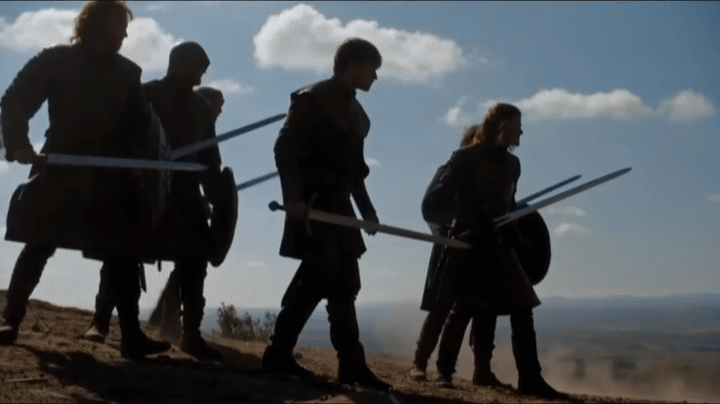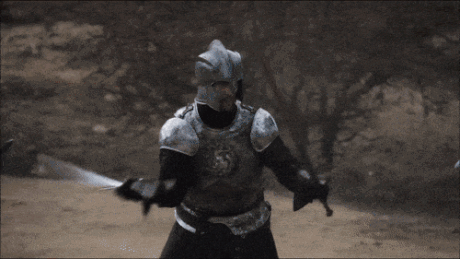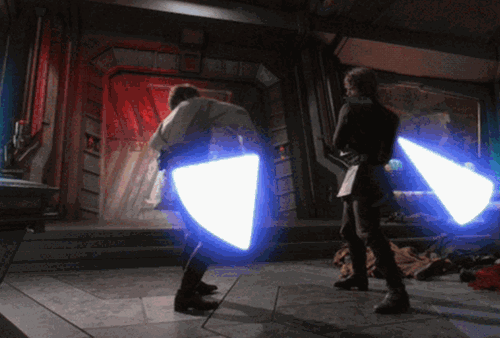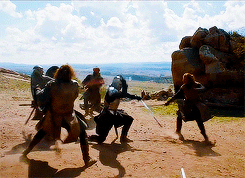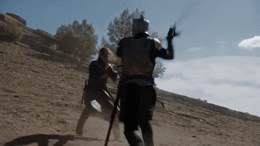
The Swordsman's Standard
The Tower of Joy
Let’s just get this out of the way: Ned Stark should have brought more men and maybe an archer or two, swinging around two swords at once is ill-advised, the four-on-one fight looked so theatrical that it could have been in a Star Wars prequel, and Ned could have killed Dayne by attacking from behind at any point. Now that we got that unpleasantness is out of the way, let’s take a look at the Tower of Joy fight scene.
There are lots of theatric moments during both the group fight and the duel between Arthur Dayne and Ned Stark. However, the two of them also show some impressive technique and more often than not launch attacks with real and believable intentions to kill each other. We see some stage swordfighting, but there’s enough meat here for us to get into details.
Before I begin, I want to make a quick note about Dayne’s fighting style. Dual-wielded swords are pretty much unheard of south of the wall. The weight of a full-length sword in someone’s off hand would be very difficult to manage, and according to conventional techniques there would be no benefit to having a second sword that one could not also get from replacing it with a parry dagger or a buckler. Historically, it is not uncommon for people to have fought with a rapier in each hand, though they would have been used as thrusting rather than cutting weapons; it’s the act of swinging around two swords at once that’s hard to defend. That being said, I’m not here to assess whether or not the weapons that a character uses are historically accurate but rather to determine how good they are with them. I am perfectly willing to assume that Arthur Dayne put in the many hours necessary to train both hands to be effective with that large of a weapon. He is supposed to be the greatest swordsman who ever lived. While the most accurate way to demonstrate this would be to have him cut down Ned & Friends within a few seconds, this makes for bad television.
So instead, we get Dayne holding two swords. I concede that his style is way off from a historical perspective, but I’ll go with it as far as assessing how well he fights. In Dayne’s defense, we see a couple of attacks where he either sets up his swords in a scissoring position to cut someone’s throat or swings both weapons together to hit with more power than he could otherwise. Because there’s no reason to suspect that “the greatest swordsman [Ned Stark] has ever seen” would have endangered himself by fighting in a way that he wasn’t prepared to do and because we see him make use of both swords, I have no reason to demerit or exclude Dayne for his peculiar style.
On to the battle itself. The way I see it, this fight scene has three components. First off, there’s the brawl where Arthur Dayne fights four people at once, then there’s the parts within that larger brawl where Ned takes on Oswell Whent and Dayne takes out singular opponents. Finally, there’s the duel between Stark and Dayne, which ended with the most frustrating backstabbing ever. Let’s start with the group fight.
This is the most damning part of the fight — there are lots of big attacks and huge, sweeping parries accompanied by dramatic grunts. Dayne spins his swords around like a bad cosplayer and Stark’s cohorts attack right into the pattern of spins so that it looks like Dayne is making effective parries.
Now to be fair, most of the spinning happens in between phrases of the battle and when Dayne is out of range. He’s not necessarily committing suicide with these fancy-looking twirls, but it’s not a great tactic. Even if these spinning parries were to be effective defenses, they do nothing to help Dayne actually pick off his opponents. As my fencing master says, “A parry without a riposte is like a day without sunshine.” Dayne is blocking all of the attacks coming his way, but more often than not fails to set up the conditions from which to launch a counterattack or riposte.
This is why I compare this part of the fight to the Star Wars prequels: the purpose of the fight at this point seems to be just to show off lots of cool-looking but horribly-ineffective flourishes. We know that Dayne is capable of better, because he kills two people within the first ten seconds of combat. He took out the first northerner with a quick, momentum-redirecting parry riposte action, and the other by capitalizing on how much tempo his opponent wasted by spinning around. Dayne simply placed his blade where he knew his enemy would be and ran him through.
Meanwhile, Ned Stark has an impressive kill of his own against the unnamed consolidation of Whent and Hightower, who I’m just going to call Whent because it’s fewer letters. Whent and Stark are fighting up close when Whent makes the fatal mistake of committing to a large, broad attack. While Ned could have saved some energy with a smaller parry, he clearly knows what he’s doing. We can see that Stark is controlling the situation because he is able to take a wide parry of his own, cross blades, and redirect Whent’s momentum into the ground without compromising his own balance. In such short distance, this tempo advantage becomes a deciding factor and Stark, still very much poised and in control of his body, is able to recover his weapon and run Whent through the throat while he’s still stumbling forward. Very quick, very clean and deliberate; this is the kind of bladework that I like to see from higher-ranked characters.
Based on his first two kills, we know that the show’s representation of Arthur Dayne is capable of living up to his reputation as one of the best swordsmen in Westerosi history, which is why his fight against a group of people looks so ridiculous and damning in comparison to how quickly he can dispatch a single assailant. Once Dayne is the only remaining kingsguard, we get right back into some Revenge of the Sith silliness. Dayne lets himself get surrounded and then stays there, spinning both his body and his swords while people attack him from all sides.
This part of the fight is excessively theatrical – there’s no feasible way that Dayne could have survived. They show him making successful parries against multiple people at once, some of whom are behind him, by choreographing the fight such that the remaining swordsmen are making weak attacks, sometimes even after the parry that blocks them has already started. Basically, there’s no real intent to hit and kill Dayne at this point.
One point that’s interesting for character development is the fact that Stark often finds himself facing Dayne’s back at this point, and Dayne is lucky that this is the case. If you watch closely, you can see the honorable Ned Stark refuse to attack from behind, waiting instead until Dayne has spun around to face him before joining in and taking his turn to launch attacks directly into Dayne’s parries. Had any of the other swordsmen been in Ned’s position, this fight would have ended much sooner.
Finally, Dayne moves out of his central position and works to keep all four of his assailants in front of him. This is what he should have been doing from the beginning – I can’t ignore the fact that he chose to stay surrounded for a while, but I appreciate that he finally worked to take control of his surroundings. Dayne parries his way out of the middle of the fight and works to keep his remaining opponents within his line of sight as much as possible. Of course, we go back to more blade spinning – these spins function for now as parries, but that is only because Ned & Friends are launching attacks from out of distance and with poor balance. If a single one of them closed the distance and make a well-controlled attack, then they could have easily disarmed or killed Dayne. That doesn’t happen, so Dayne has plenty of opportunities to pick off his opponents one by one. The first time this happens, he takes a sudden and sharp step forward, separating one target from the rest of the group with a strong kick. Dayne keeps his balance then takes advantage of the tempo granted by his opponent’s recovery and takes him out with a dramatic but plausible spinning attack. Just like when he spins his blades, spinning like this would be incredibly risky against an alert and prepared opponent. But because his opponent is busy catching his balance, Dayne has time to spin without the risk of being run through the same way he killed the second northerner.
The next part is less believable. Dayne once more lets himself get surrounded by the remaining three men and only succeeds at cutting a northman’s throat because Stark and the remaining soldier don’t bother attacking while he does so. This is explained on screen by visible fatigue, but comes across as a very convenient failure to keep pressure on the outnumbered kingsguard. This one kill takes more than a couple tempos to set up, meaning Dayne left himself vulnerable for far too long compared to what I’m willing to justify. Now we’re down to two versus one.
The last unnamed northerner falls to what would be a very clean parry-riposte on Dayne’s part, had it been a matter of single combat. Dayne dedicates all of his attention to making a parry, running his other sword through the northerner, and holding his blades in place. The entire ordeal takes roughly five seconds – five seconds during which he is completely vulnerable and still Stark chooses to do nothing. Because he’s not visible on the screen, it’s as if he isn’t even there. This is not unlike when Jaime stared Ned down while holding his knife in Jory’s eye socket. But that time, Ned was too far away to do anything. This time, Ned was standing two feet away and chose to watch. Finally, we are down to the duel between Stark and Dayne.
This part of the fight is another highly-theatric segment. It reminded me of when Khal Drogo kills his bloodrider, Mago. Both Stark and Dayne are moving at the exact same tempo – this is one of the telltale signs that a fight is relying on stage combat rather than any sort of realistic intent. I will grant them that they avoid one of the cardinal sins of stage swordfighting: neither character prepares to block an attack that hasn’t started yet. The two swordsmen move at the same pace, but they move well, and the back and forth seems to be an indication of a fairly equivalent skill level rather than lazy writing. However, it’s interesting to note that Dayne’s tempo quickens when he uses both swords for an action rather than using just one of his arms. While this is the opposite of how the tempo of a real swordsman would be affected by dual-wielding, it is the only sign that we have of one character being superior to the other. Eventually, this slight advantage causes the back and forth to end with Ned Stark being forcefully disarmed. For our purposes, this is the decision point for the duel.
The rest of the scene doesn’t affect how Ned and Dayne will be ranked, but I felt that it was an interesting parallel to Ned’s scenes in season one. The only time that we see the honorable Ned Stark win a battle – perhaps the battle that earned him his reputation as a legendary swordsman – is because his opponent is stabbed in the back of the neck. Compare this to when Ned is incapacitated from behind by a Lannister soldier, or even when Littlefinger jumps in from behind and holds a knife to his throat. Ned makes the same expression of utter horror when Howland Reed stabs Arthur Dayne in the back as he does when he is jumped by Petyr Baelish decades later. Ned seems to be equally horrified by Reed’s backstabbing as he does by his decision to finish Dayne off – a detail that demonstrates that Ned’s earlier refusal to attack Dayne from behind must have been a deliberate character decision. Also, the dishonorably-slain Dayne collapses and looks up at Ned with the exact same expression Ned gave Jaime after being stabbed in the leg.
Aside from making a neat parallel about the role of honor in a battle, this tells us one thing: Ned Stark had fully expected Jaime to finish him off and was prepared to die right there in the street. Does this mean that Jaime, the supposed man without honor, actually treated his opponent with more respect than the reputably-dignified Ned Stark? Maybe. On one hand, Ned claimed a dishonorable victory when he finished off Arthur Dayne by claiming the advantage granted by his ally’s opportunistic backstabbing. However, there is enough wiggle room to defend Stark: Dayne’s injury was most likely fatal, so Ned’s decision to finish him off could be seen as an act of mercy rather than the decision to take advantage of an opponent who couldn’t defend himself. Had Jaime done the same to Ned, who was severely wounded but not mortally so, then it would have tarnished his image even more than it already was. Regardless of this speculation, I found moments of this battle impressive enough that both Arthur Dayne and young Ned Stark will be added to my tier list.
Next: The Battle of the Bastards
Edit: One astute reader pointed out an error on my part. What I had described as Dayne's first kill, not counting when he immediately incapacitated Howland Reed, was actually performed by Whent. The reader pointed out that Dayne is seen dueling Ned in the background as Whent kills his opponent. Also, Whent uses his off-hand to help throw the northerner off balance as he spins, which is something that Dayne's second sword would have prevent him from doing. Previously, I had given all of the credit to Dayne as I hadn't realized that Whent had actually contributed to the fight.


